CLWM4100 Taxation Law: Individual Case Study Assignment Analysis
VerifiedAdded on 2023/06/08
|6
|1416
|298
Case Study
AI Summary
This taxation law case study analyzes Elwood's tax position, addressing key aspects such as establishing a new business, the sale of assets, and claiming general deductions. The analysis determines Elwood's tax residency status, considering the place of incorporation, voting power, and central management. It examines the tax implications of various asset sales, including a car, vacant land, shares, an antique, jewelry, and quotas, applying the relevant provisions of the ITAA 1997. The study also evaluates the deductibility of interest expenses and advertisement campaign costs, based on the criteria outlined in s. 8-1 ITAA 1997 and relevant case law. The assignment provides detailed tax advice, supported by references to legislation and case law, offering a comprehensive understanding of Australian taxation principles.
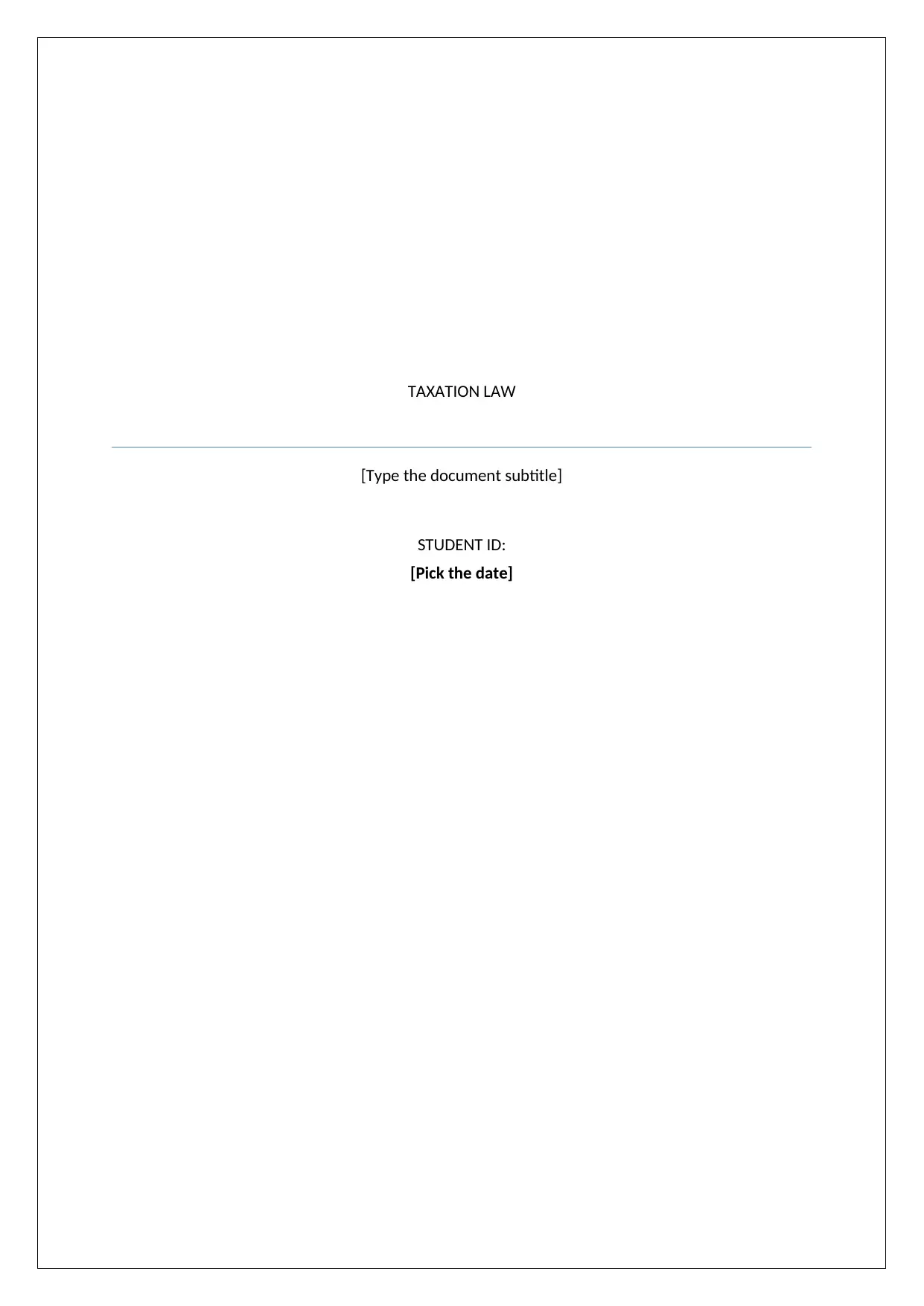
TAXATION LAW
[Type the document subtitle]
STUDENT ID:
[Pick the date]
[Type the document subtitle]
STUDENT ID:
[Pick the date]
Paraphrase This Document
Need a fresh take? Get an instant paraphrase of this document with our AI Paraphraser
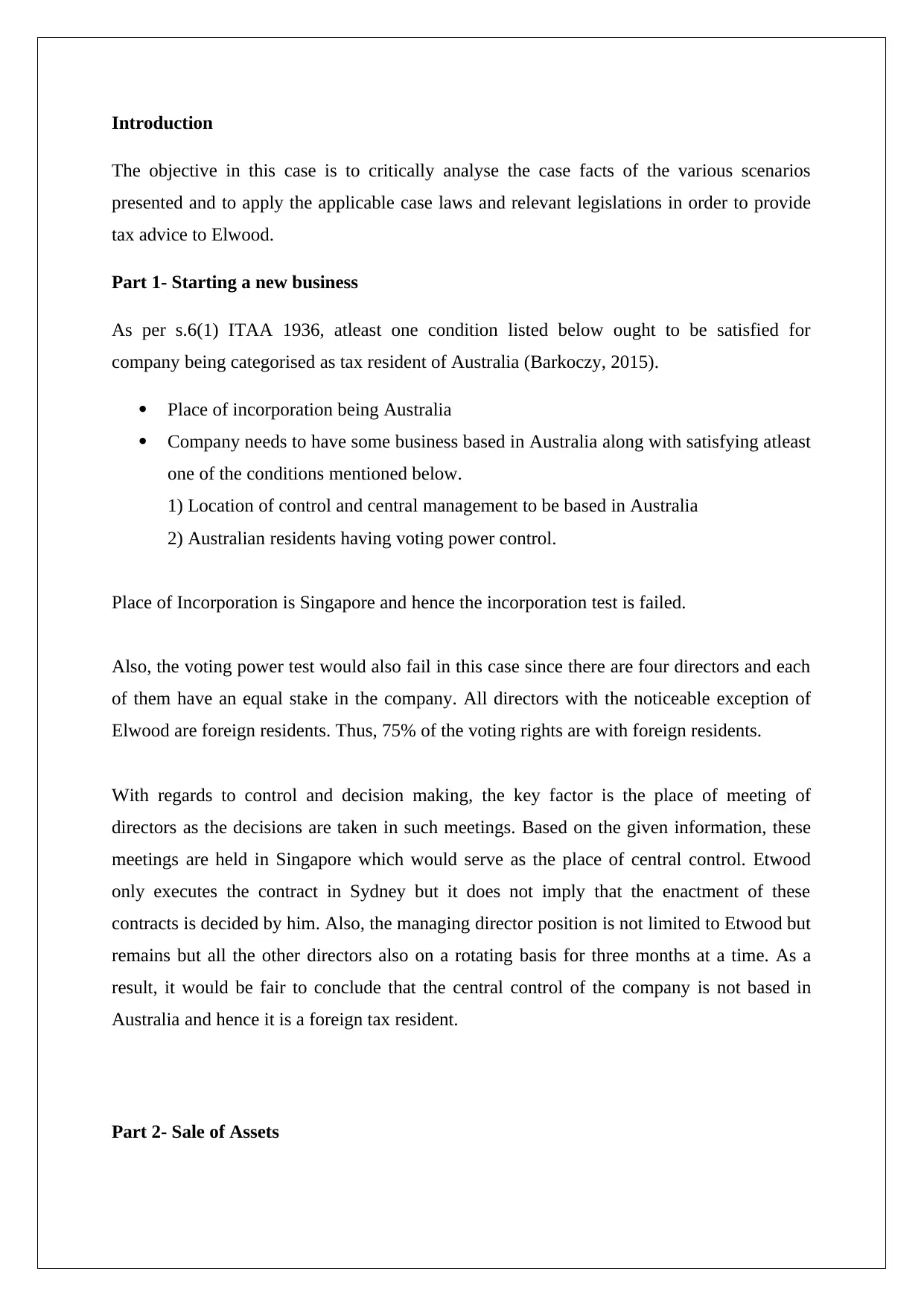
Introduction
The objective in this case is to critically analyse the case facts of the various scenarios
presented and to apply the applicable case laws and relevant legislations in order to provide
tax advice to Elwood.
Part 1- Starting a new business
As per s.6(1) ITAA 1936, atleast one condition listed below ought to be satisfied for
company being categorised as tax resident of Australia (Barkoczy, 2015).
Place of incorporation being Australia
Company needs to have some business based in Australia along with satisfying atleast
one of the conditions mentioned below.
1) Location of control and central management to be based in Australia
2) Australian residents having voting power control.
Place of Incorporation is Singapore and hence the incorporation test is failed.
Also, the voting power test would also fail in this case since there are four directors and each
of them have an equal stake in the company. All directors with the noticeable exception of
Elwood are foreign residents. Thus, 75% of the voting rights are with foreign residents.
With regards to control and decision making, the key factor is the place of meeting of
directors as the decisions are taken in such meetings. Based on the given information, these
meetings are held in Singapore which would serve as the place of central control. Etwood
only executes the contract in Sydney but it does not imply that the enactment of these
contracts is decided by him. Also, the managing director position is not limited to Etwood but
remains but all the other directors also on a rotating basis for three months at a time. As a
result, it would be fair to conclude that the central control of the company is not based in
Australia and hence it is a foreign tax resident.
Part 2- Sale of Assets
The objective in this case is to critically analyse the case facts of the various scenarios
presented and to apply the applicable case laws and relevant legislations in order to provide
tax advice to Elwood.
Part 1- Starting a new business
As per s.6(1) ITAA 1936, atleast one condition listed below ought to be satisfied for
company being categorised as tax resident of Australia (Barkoczy, 2015).
Place of incorporation being Australia
Company needs to have some business based in Australia along with satisfying atleast
one of the conditions mentioned below.
1) Location of control and central management to be based in Australia
2) Australian residents having voting power control.
Place of Incorporation is Singapore and hence the incorporation test is failed.
Also, the voting power test would also fail in this case since there are four directors and each
of them have an equal stake in the company. All directors with the noticeable exception of
Elwood are foreign residents. Thus, 75% of the voting rights are with foreign residents.
With regards to control and decision making, the key factor is the place of meeting of
directors as the decisions are taken in such meetings. Based on the given information, these
meetings are held in Singapore which would serve as the place of central control. Etwood
only executes the contract in Sydney but it does not imply that the enactment of these
contracts is decided by him. Also, the managing director position is not limited to Etwood but
remains but all the other directors also on a rotating basis for three months at a time. As a
result, it would be fair to conclude that the central control of the company is not based in
Australia and hence it is a foreign tax resident.
Part 2- Sale of Assets
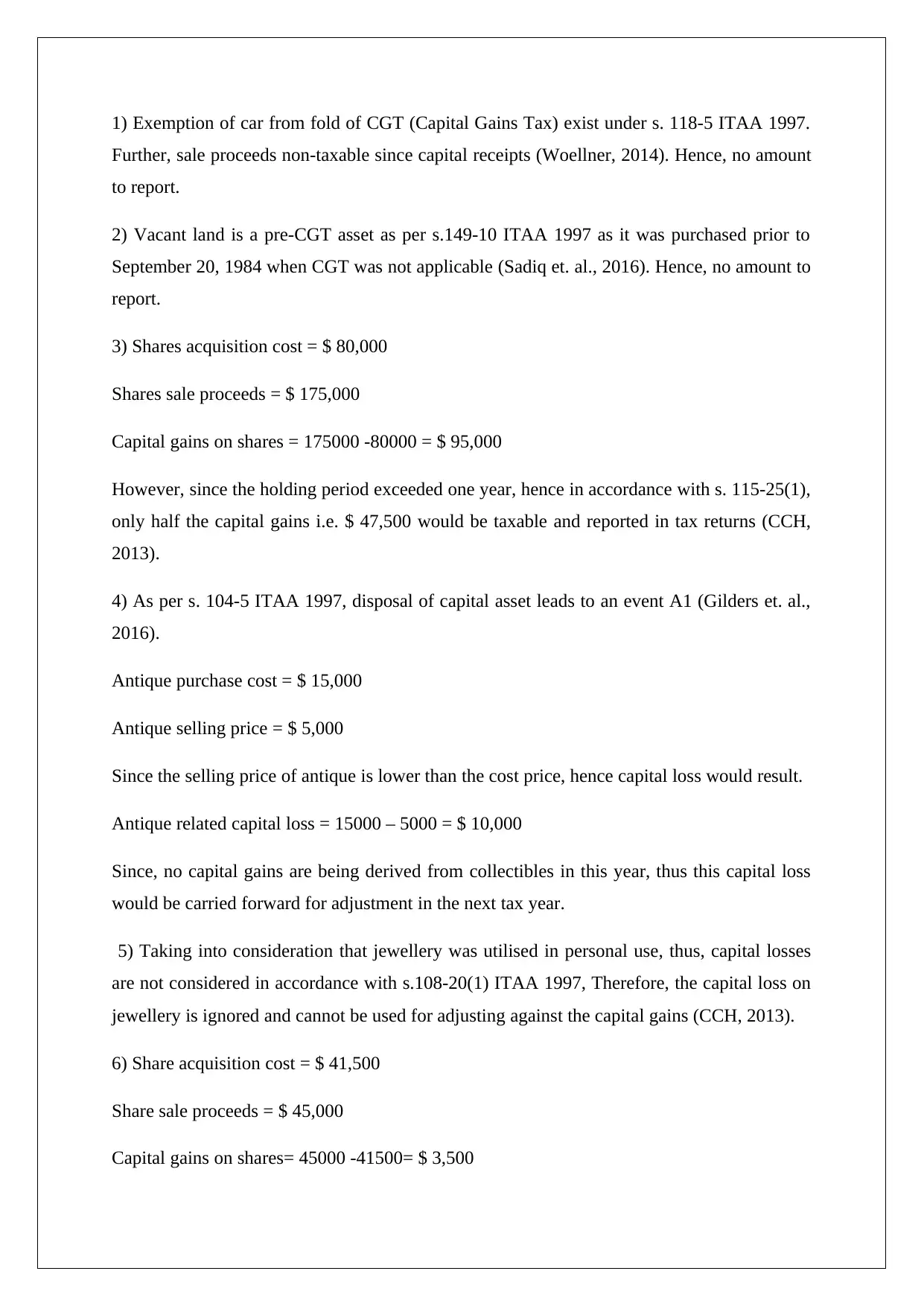
1) Exemption of car from fold of CGT (Capital Gains Tax) exist under s. 118-5 ITAA 1997.
Further, sale proceeds non-taxable since capital receipts (Woellner, 2014). Hence, no amount
to report.
2) Vacant land is a pre-CGT asset as per s.149-10 ITAA 1997 as it was purchased prior to
September 20, 1984 when CGT was not applicable (Sadiq et. al., 2016). Hence, no amount to
report.
3) Shares acquisition cost = $ 80,000
Shares sale proceeds = $ 175,000
Capital gains on shares = 175000 -80000 = $ 95,000
However, since the holding period exceeded one year, hence in accordance with s. 115-25(1),
only half the capital gains i.e. $ 47,500 would be taxable and reported in tax returns (CCH,
2013).
4) As per s. 104-5 ITAA 1997, disposal of capital asset leads to an event A1 (Gilders et. al.,
2016).
Antique purchase cost = $ 15,000
Antique selling price = $ 5,000
Since the selling price of antique is lower than the cost price, hence capital loss would result.
Antique related capital loss = 15000 – 5000 = $ 10,000
Since, no capital gains are being derived from collectibles in this year, thus this capital loss
would be carried forward for adjustment in the next tax year.
5) Taking into consideration that jewellery was utilised in personal use, thus, capital losses
are not considered in accordance with s.108-20(1) ITAA 1997, Therefore, the capital loss on
jewellery is ignored and cannot be used for adjusting against the capital gains (CCH, 2013).
6) Share acquisition cost = $ 41,500
Share sale proceeds = $ 45,000
Capital gains on shares= 45000 -41500= $ 3,500
Further, sale proceeds non-taxable since capital receipts (Woellner, 2014). Hence, no amount
to report.
2) Vacant land is a pre-CGT asset as per s.149-10 ITAA 1997 as it was purchased prior to
September 20, 1984 when CGT was not applicable (Sadiq et. al., 2016). Hence, no amount to
report.
3) Shares acquisition cost = $ 80,000
Shares sale proceeds = $ 175,000
Capital gains on shares = 175000 -80000 = $ 95,000
However, since the holding period exceeded one year, hence in accordance with s. 115-25(1),
only half the capital gains i.e. $ 47,500 would be taxable and reported in tax returns (CCH,
2013).
4) As per s. 104-5 ITAA 1997, disposal of capital asset leads to an event A1 (Gilders et. al.,
2016).
Antique purchase cost = $ 15,000
Antique selling price = $ 5,000
Since the selling price of antique is lower than the cost price, hence capital loss would result.
Antique related capital loss = 15000 – 5000 = $ 10,000
Since, no capital gains are being derived from collectibles in this year, thus this capital loss
would be carried forward for adjustment in the next tax year.
5) Taking into consideration that jewellery was utilised in personal use, thus, capital losses
are not considered in accordance with s.108-20(1) ITAA 1997, Therefore, the capital loss on
jewellery is ignored and cannot be used for adjusting against the capital gains (CCH, 2013).
6) Share acquisition cost = $ 41,500
Share sale proceeds = $ 45,000
Capital gains on shares= 45000 -41500= $ 3,500
⊘ This is a preview!⊘
Do you want full access?
Subscribe today to unlock all pages.

Trusted by 1+ million students worldwide
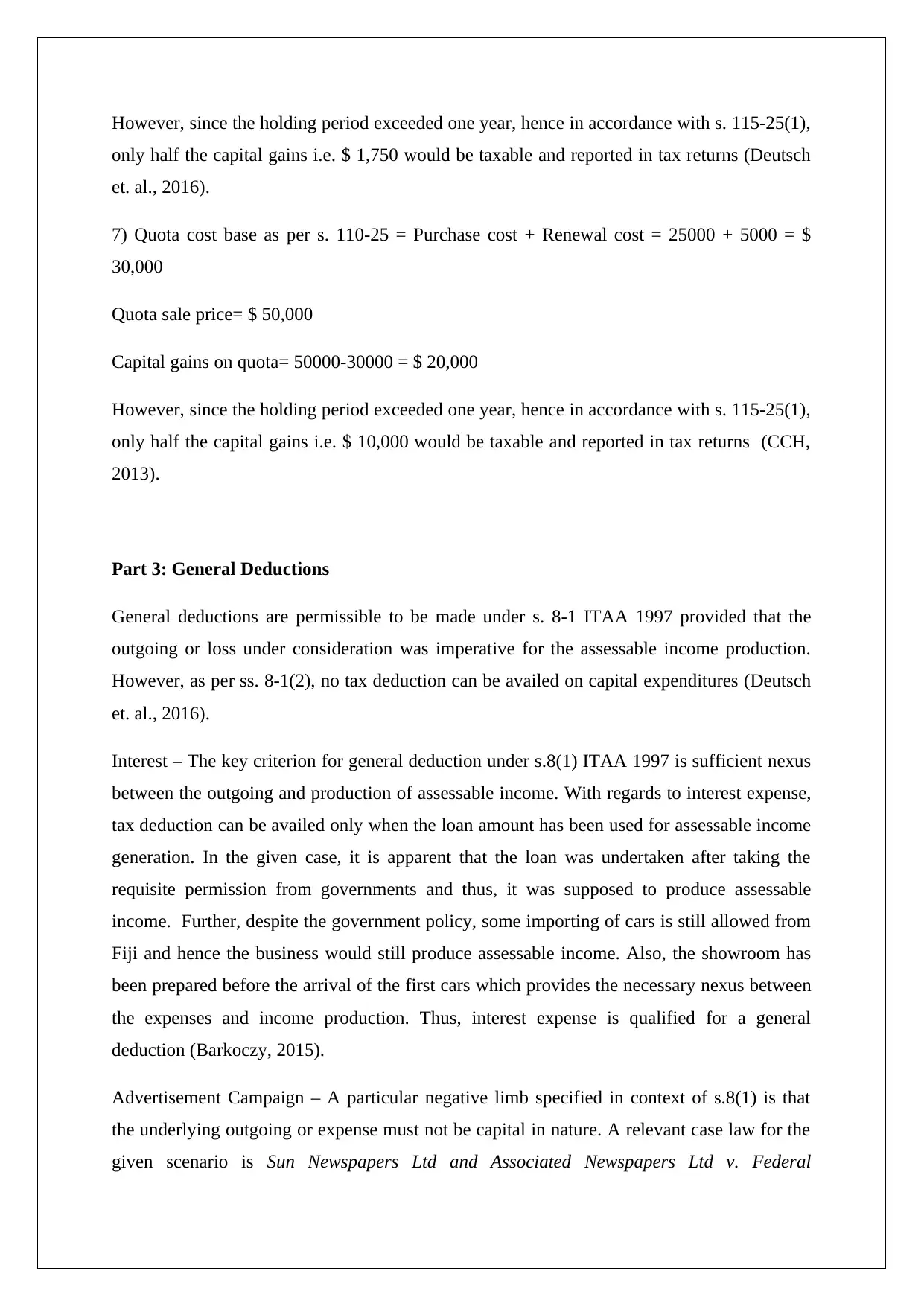
However, since the holding period exceeded one year, hence in accordance with s. 115-25(1),
only half the capital gains i.e. $ 1,750 would be taxable and reported in tax returns (Deutsch
et. al., 2016).
7) Quota cost base as per s. 110-25 = Purchase cost + Renewal cost = 25000 + 5000 = $
30,000
Quota sale price= $ 50,000
Capital gains on quota= 50000-30000 = $ 20,000
However, since the holding period exceeded one year, hence in accordance with s. 115-25(1),
only half the capital gains i.e. $ 10,000 would be taxable and reported in tax returns (CCH,
2013).
Part 3: General Deductions
General deductions are permissible to be made under s. 8-1 ITAA 1997 provided that the
outgoing or loss under consideration was imperative for the assessable income production.
However, as per ss. 8-1(2), no tax deduction can be availed on capital expenditures (Deutsch
et. al., 2016).
Interest – The key criterion for general deduction under s.8(1) ITAA 1997 is sufficient nexus
between the outgoing and production of assessable income. With regards to interest expense,
tax deduction can be availed only when the loan amount has been used for assessable income
generation. In the given case, it is apparent that the loan was undertaken after taking the
requisite permission from governments and thus, it was supposed to produce assessable
income. Further, despite the government policy, some importing of cars is still allowed from
Fiji and hence the business would still produce assessable income. Also, the showroom has
been prepared before the arrival of the first cars which provides the necessary nexus between
the expenses and income production. Thus, interest expense is qualified for a general
deduction (Barkoczy, 2015).
Advertisement Campaign – A particular negative limb specified in context of s.8(1) is that
the underlying outgoing or expense must not be capital in nature. A relevant case law for the
given scenario is Sun Newspapers Ltd and Associated Newspapers Ltd v. Federal
only half the capital gains i.e. $ 1,750 would be taxable and reported in tax returns (Deutsch
et. al., 2016).
7) Quota cost base as per s. 110-25 = Purchase cost + Renewal cost = 25000 + 5000 = $
30,000
Quota sale price= $ 50,000
Capital gains on quota= 50000-30000 = $ 20,000
However, since the holding period exceeded one year, hence in accordance with s. 115-25(1),
only half the capital gains i.e. $ 10,000 would be taxable and reported in tax returns (CCH,
2013).
Part 3: General Deductions
General deductions are permissible to be made under s. 8-1 ITAA 1997 provided that the
outgoing or loss under consideration was imperative for the assessable income production.
However, as per ss. 8-1(2), no tax deduction can be availed on capital expenditures (Deutsch
et. al., 2016).
Interest – The key criterion for general deduction under s.8(1) ITAA 1997 is sufficient nexus
between the outgoing and production of assessable income. With regards to interest expense,
tax deduction can be availed only when the loan amount has been used for assessable income
generation. In the given case, it is apparent that the loan was undertaken after taking the
requisite permission from governments and thus, it was supposed to produce assessable
income. Further, despite the government policy, some importing of cars is still allowed from
Fiji and hence the business would still produce assessable income. Also, the showroom has
been prepared before the arrival of the first cars which provides the necessary nexus between
the expenses and income production. Thus, interest expense is qualified for a general
deduction (Barkoczy, 2015).
Advertisement Campaign – A particular negative limb specified in context of s.8(1) is that
the underlying outgoing or expense must not be capital in nature. A relevant case law for the
given scenario is Sun Newspapers Ltd and Associated Newspapers Ltd v. Federal
Paraphrase This Document
Need a fresh take? Get an instant paraphrase of this document with our AI Paraphraser
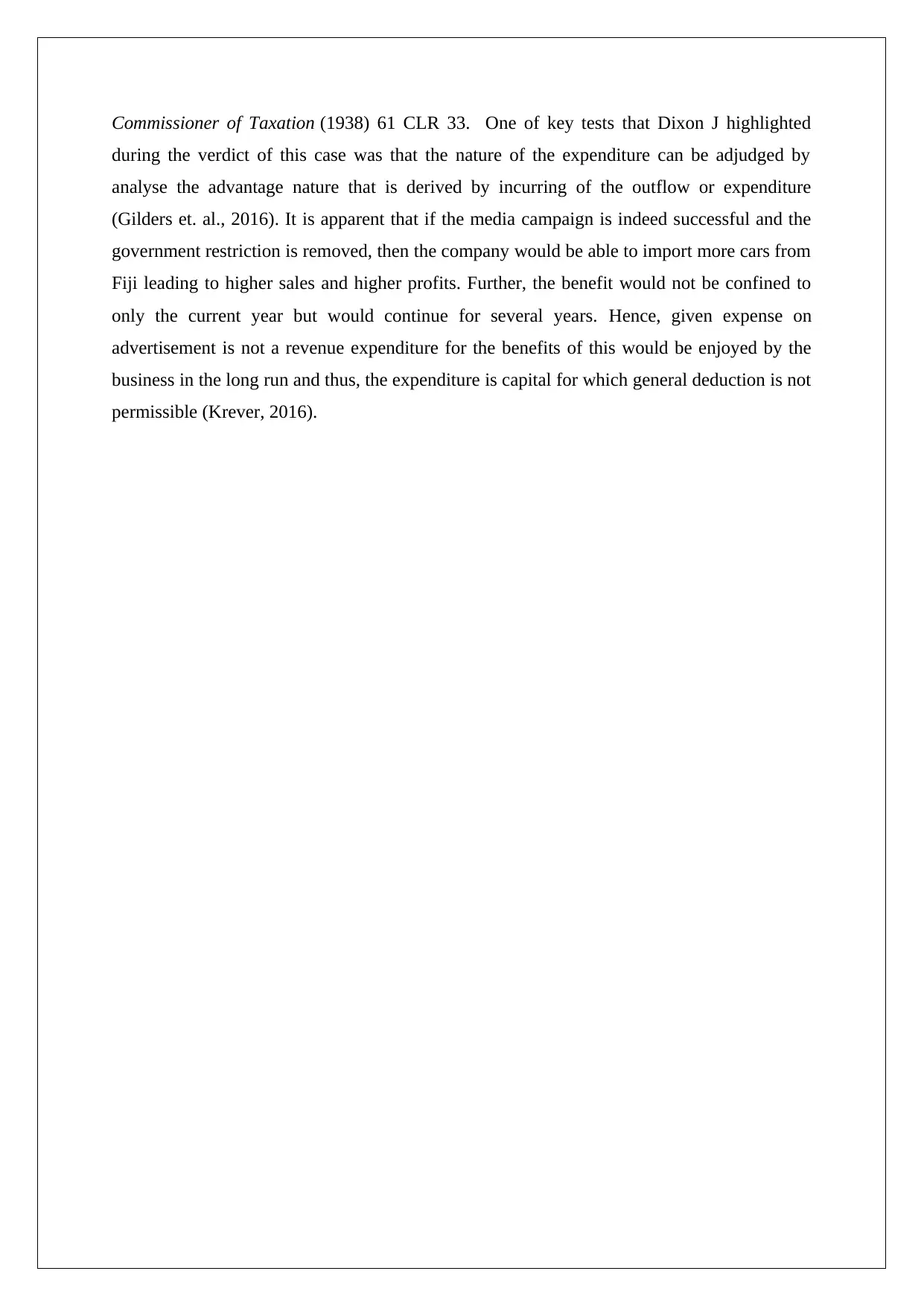
Commissioner of Taxation (1938) 61 CLR 33. One of key tests that Dixon J highlighted
during the verdict of this case was that the nature of the expenditure can be adjudged by
analyse the advantage nature that is derived by incurring of the outflow or expenditure
(Gilders et. al., 2016). It is apparent that if the media campaign is indeed successful and the
government restriction is removed, then the company would be able to import more cars from
Fiji leading to higher sales and higher profits. Further, the benefit would not be confined to
only the current year but would continue for several years. Hence, given expense on
advertisement is not a revenue expenditure for the benefits of this would be enjoyed by the
business in the long run and thus, the expenditure is capital for which general deduction is not
permissible (Krever, 2016).
during the verdict of this case was that the nature of the expenditure can be adjudged by
analyse the advantage nature that is derived by incurring of the outflow or expenditure
(Gilders et. al., 2016). It is apparent that if the media campaign is indeed successful and the
government restriction is removed, then the company would be able to import more cars from
Fiji leading to higher sales and higher profits. Further, the benefit would not be confined to
only the current year but would continue for several years. Hence, given expense on
advertisement is not a revenue expenditure for the benefits of this would be enjoyed by the
business in the long run and thus, the expenditure is capital for which general deduction is not
permissible (Krever, 2016).
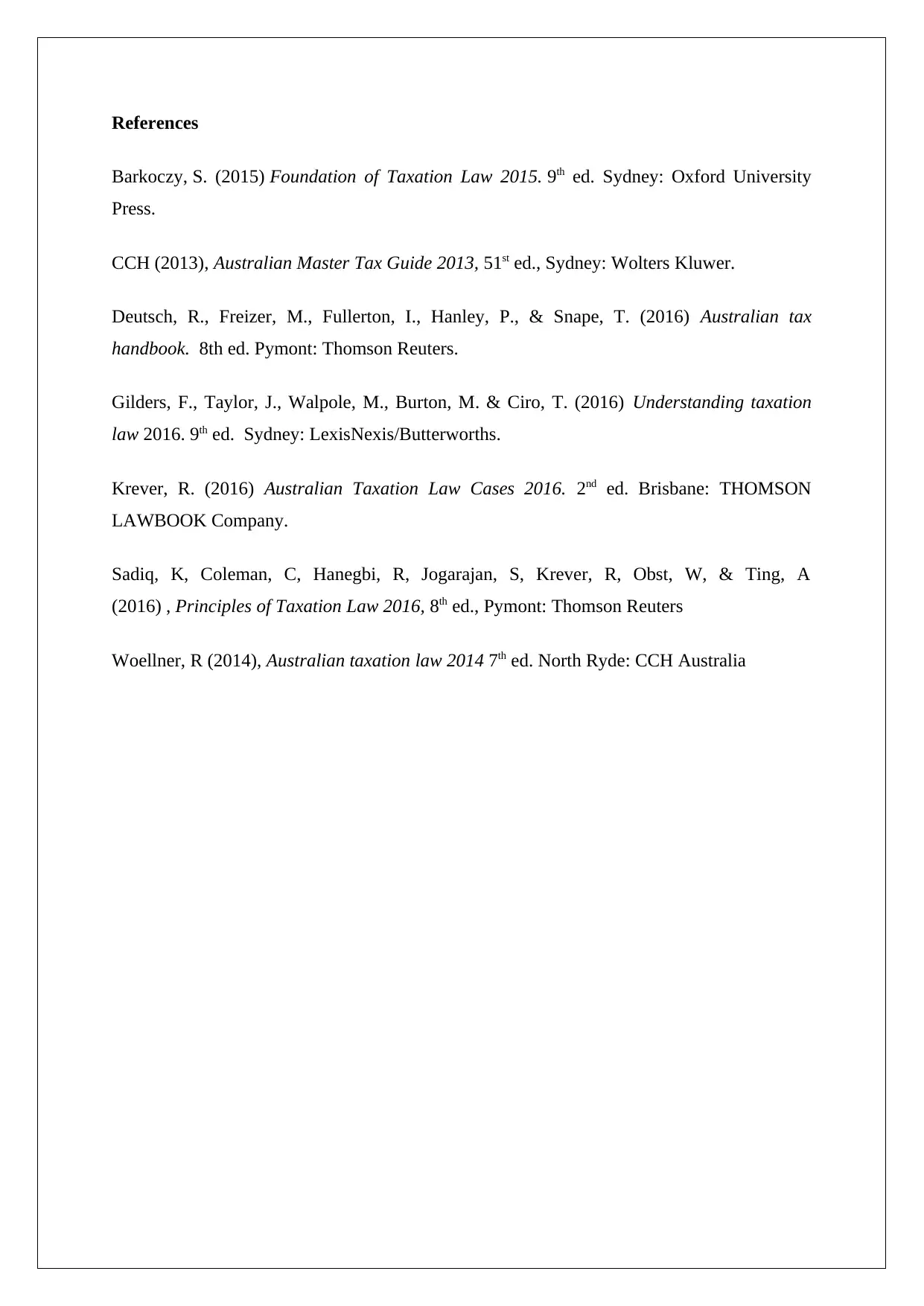
References
Barkoczy, S. (2015) Foundation of Taxation Law 2015. 9th ed. Sydney: Oxford University
Press.
CCH (2013), Australian Master Tax Guide 2013, 51st ed., Sydney: Wolters Kluwer.
Deutsch, R., Freizer, M., Fullerton, I., Hanley, P., & Snape, T. (2016) Australian tax
handbook. 8th ed. Pymont: Thomson Reuters.
Gilders, F., Taylor, J., Walpole, M., Burton, M. & Ciro, T. (2016) Understanding taxation
law 2016. 9th ed. Sydney: LexisNexis/Butterworths.
Krever, R. (2016) Australian Taxation Law Cases 2016. 2nd ed. Brisbane: THOMSON
LAWBOOK Company.
Sadiq, K, Coleman, C, Hanegbi, R, Jogarajan, S, Krever, R, Obst, W, & Ting, A
(2016) , Principles of Taxation Law 2016, 8th ed., Pymont: Thomson Reuters
Woellner, R (2014), Australian taxation law 2014 7th ed. North Ryde: CCH Australia
Barkoczy, S. (2015) Foundation of Taxation Law 2015. 9th ed. Sydney: Oxford University
Press.
CCH (2013), Australian Master Tax Guide 2013, 51st ed., Sydney: Wolters Kluwer.
Deutsch, R., Freizer, M., Fullerton, I., Hanley, P., & Snape, T. (2016) Australian tax
handbook. 8th ed. Pymont: Thomson Reuters.
Gilders, F., Taylor, J., Walpole, M., Burton, M. & Ciro, T. (2016) Understanding taxation
law 2016. 9th ed. Sydney: LexisNexis/Butterworths.
Krever, R. (2016) Australian Taxation Law Cases 2016. 2nd ed. Brisbane: THOMSON
LAWBOOK Company.
Sadiq, K, Coleman, C, Hanegbi, R, Jogarajan, S, Krever, R, Obst, W, & Ting, A
(2016) , Principles of Taxation Law 2016, 8th ed., Pymont: Thomson Reuters
Woellner, R (2014), Australian taxation law 2014 7th ed. North Ryde: CCH Australia
⊘ This is a preview!⊘
Do you want full access?
Subscribe today to unlock all pages.

Trusted by 1+ million students worldwide
1 out of 6
Related Documents
Your All-in-One AI-Powered Toolkit for Academic Success.
+13062052269
info@desklib.com
Available 24*7 on WhatsApp / Email
![[object Object]](/_next/static/media/star-bottom.7253800d.svg)
Unlock your academic potential
Copyright © 2020–2025 A2Z Services. All Rights Reserved. Developed and managed by ZUCOL.



